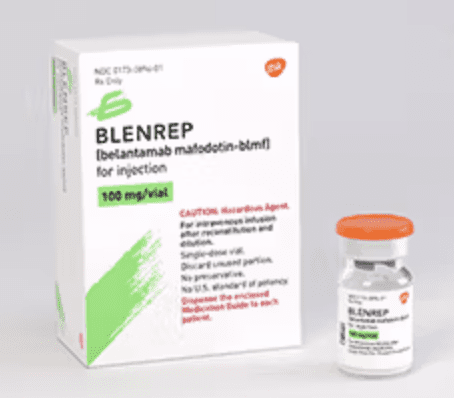Belantamab mafodotin Disease Interactions
There are 3 disease interactions with belantamab mafodotin.
Belantamab mafodotin (applies to belantamab mafodotin) visual disturbances
Major Potential Hazard, Moderate plausibility. Applicable conditions: Visual Defect/Disturbance
Belantamab has caused ocular toxicity resulting in changes in vision, including severe vision loss and corneal ulcer, and symptoms such as blurred vision and dry eyes. Caution and close monitoring is advised in patients with preexisting visual disturbances. Ophthalmic exams should be performed at baseline, prior to each dose, and promptly for new or worsening symptom. Due to the risk of ocular toxicity, this drug is only available through a restricted program under the Risk Evaluation and Mitigation Strategy (REMS).
Belantamab mafodotin (applies to belantamab mafodotin) liver dysfunction
Moderate Potential Hazard, Moderate plausibility. Applicable conditions: Liver Disease
Belantamab has not been studied in patients with moderate or severe hepatic impairment. Caution is advised. No dosage modification is required in patients with mild hepatic impairment.
Belantamab mafodotin (applies to belantamab mafodotin) renal dysfunction
Moderate Potential Hazard, Moderate plausibility.
Belantamab has not been studied in patients with severe renal impairment, or end-stage renal disease not on dialysis or in dialysis. Caution is advised. No dosage modification is required in patients with mild or moderate renal impairment.
Switch to professional interaction data
Belantamab mafodotin drug interactions
There are 179 drug interactions with belantamab mafodotin.
More about belantamab mafodotin
- belantamab mafodotin consumer information
- Check interactions
- Compare alternatives
- Reviews (1)
- Side effects
- Dosage information
- During pregnancy
- Drug class: miscellaneous antineoplastics
- Breastfeeding
Related treatment guides
Drug Interaction Classification
| Highly clinically significant. Avoid combinations; the risk of the interaction outweighs the benefit. | |
| Moderately clinically significant. Usually avoid combinations; use it only under special circumstances. | |
| Minimally clinically significant. Minimize risk; assess risk and consider an alternative drug, take steps to circumvent the interaction risk and/or institute a monitoring plan. | |
| No interaction information available. |
See also:
Further information
Always consult your healthcare provider to ensure the information displayed on this page applies to your personal circumstances.


